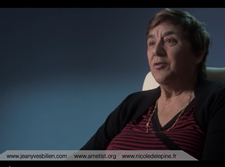

Témoignage Intégral de Carine Curtet
Présidente de l'Association AMETIST
 Témoignage Intégral du Dr Delépine
Témoignage Intégral du Dr Delépine
Pour le film Cancer Business Mortel



Si vous souhaitez contacter Nicole Delepine
Rendez-vous sur son site :

|
|
 |
 |
Importance of individualisation of HD-MTX in osteosarcoma
N. Delépine Pediatric Oncologic Unit R.Poincarré Hospital Garches France
Every human being is unique at birth.
We are all different : 3 main races And so many others..
As we increase our experiences (food, illness, medications, environmental status) are unique and increase our differences
We are all different, all unique: Different weights
We are all unique, all different : Different sizes
These differences are not all well counterbalanced by the dosage in gr/m²
Our pharmacokinetics of anticancer drugs are all unique, all different.
Interindividual variability of Serum peak of MTX after an 6 hours infusion of 12 grs/ M² H6 Serum peak µmol/L
Pharmacockinetics of HD MTX. Conclusion about 622 courses performed in 4 years in children, teenager and adults. N. Delepine, G. Delepine, J.C. Desbois, H. Cornille, B. Brun, V. Subovici, S. Alkallaf,
S. Nejmeh, C. Jasmin Medical and Pediatric Oncology Vol 17 number 4 -page 304 ; 1989
Tailoring the dose according individual PK
• If you infuse 12gr/sqm of MTX in 6 hours the peak of methotrexatemia can reach 2500 µmol /L or 350µmol/L resulting in increased risk of toxicity for some patients or ineffectiveness of
treatment for others.
• Tailoring the dose according individual PK permits to overcome the inter individual variability for optimal therapeutic use.
But Osteosarcomas are all different, all unique.
• Many histologic subtypes :
– commun type
– anaplasic
– chondroblastic
– telangectasic
– fibroblastic...
• Many radiologic subtypes :
• Many differents of cellular drug resistance.
The presumed intrinsic MTX resistance has been ascribed to an impaired MTX polyglutamylation associated with both a decrease in FPGS activity and an increase in activity of FPGH.In addition, MTX uptake may be defective as observed whereas also high levels of (altered) DHFR have been reported osteoblastic.
But Osteosarcomas are all different, all unique.
the genomic determinants of the antitumoral effects of MTX remain to be elucidated.
• The pharmacokinetics and pharmacodynamics of MTX in OS cells are well understood. Cellular uptake of MTX is mediated by the protein reduced folate carrier, whereas its efflux is mediated by ATP-binding cassette (ABC), subfamily C 1 (ABCC1) and ABCC4 .
• MTX is a tight-binding inhibitor of its primary target, enzyme dihydrofolate reductase (DHFR), which disrupts cellular folate metabolism. Within cells, MTX is metabolized into poly(.-glutamate) forms (MTXPGs) by an adenosine triphosphate (ATP)-dependent reaction catalyzed by folylpolyglutamate synthetase.
such situation is comparable to treatment of severe septicemia.
• Bacteriologists use pharmacokinetics to adapt dose of antibiotics to individual PK
• and antibiogram to estimate the optimal serum concentration.
Which drug ?
• Only two agents effective against osteosarcoma have a large therapeutic index permitting significant increase of dose : MTX and Ifosfamide .
• These two drugs demonstrated a dose/effect correlation on osteosarcoma.
Why do we prefer HDMTX ?
• MTX offers many advantages : It represents the only drug whose total dose and dose intensity are statistically correlated with 5 year disease free survival of patients
– it can be infused with a weekly interval,
– the pharmacokinetics can be easily studied,
– the toxicity can be rescued by folinic acid,
– and aplasia is usually not a problem when MTX is administrated in monotherapy.
– For these reasons we use only MTX in preoperative CHT.
Jaffe demonstrated the correlation dosdemonstrated the correlation dose intensity of MTX/response of OS.
We have observed that mean methotrexatemia during preoperative phase is correlated with response.
Correlation between seric methotrexate level and histologic response in osteogenic sarcoma. N. Delepine, G. Delepine, JC DesboisMedical and paediatric oncology -Vol. 19 n° 5/1991
Too low :ineffectivness Dose dilemna
Too high: toxicity
But no gold standard for dose of MTX !
• Pharmacokinetics of patients are individual.
• Resulting for a fixed dose, in increased risk of toxicity for some patients and ineffectiveness of treatment for many others.
The resistance of OS to MTX cannot be accurately measured by in vitro methods such as the MTT assay
• For this reason, we used the in vivo response of newly diagnosed patients to initial single-agent MTX treatment, measured as an initial decrease in tumoral vascularization, to quantitate the antiosteosarcoma effects of MTX
Rationale of preoperative chemotherapy
• Rosen thought that the follow up of the tumor during chemotherapy could permit to realize an antimitogram in vivo
• He gave preoperative chemotherapy to optimize the dose for an unique patient.
30 years ago G Rosen underlined that preoperative chemotherapy is an investigative method , Not a recipe Allowed us to determine the optimal dose of HDMTX for each patient
Preoperative chemotherapy permits to find “the optimal dosage” for individual patient.
But all multicentric protocols derivated from Rosen forgot the rationale
• They used the same dose for all patients.
• Resulting in too much toxicity in some patients
• And suboptimal dosage of MTX in others
• They did not reproduce the method
• they did not reproduce the results
We tried to apply Rosen ’s rationale • As soon after biopsy we start with HDMTX (8 to 15 G/Sqm according to age) with complete PK study.
• On D7 the second curse is administered with a tailored dose to obtain :
• a clinical response of the primary (decreasing of local hyperthermia and vascularisation).
• And a serum peak of 1000µmole/L
During preoperative chemotherapy the surgeon must evaluate the tumor every week
• we increase the dose
• If the serum peak is too low
• less than 1000µmol/l if infusion of 6 hours
• Rosen propose 1450µmol/l for an infusion of 4 hours
• if pain or local hyperthermia remains
MTX doses are increased if the serum peak is too low of if tumor does not respond enough OS.
60% of our patients received escalating doses
• The mean increase of dose is 40%; We had sometimes to increase the dose up to 22 G/Sqm per curse.
• With such a method we always obtain clinical response of primary OS and never more observe progression of disease during preop chemotherapy.
• With a reinforced rescue they do not suffer of increased toxicity
• 4 to 5 courses of individualized doses of MTX are enough for surgeon even in case of fracture
Preoperative chemotherapy can be dangerous
Too long preoperative chemotherapy may be dangerous if chemotherapy is not effective enough and may increase the risk of induction of chemoresistance and of metastases.
Timing of surgery
• After usually 4 courses we resect the tumor.
In our practice we never need to primary amputate patients seen before biopsy.
• Peri operative chemotherapy is administered immediately following surgery (day 2 to day 4) using Ifosfamide alone.
Postoperative chemotherapy
• uses HDMTX ( 12 additional courses at the effective dose), IFO (3 courses with 12 G/m² or more ), Theprubicin and CDDP (3 courses).
• We use the same drugs in good and bad responders
• Bad responders received two cycles more.
Conclusions
– We are all unique , all different.
– Osteosarcomas are all different.
– We all know that tailored suit fit us better than standardized suit.
– We treat severe infection with individualized antibio therapy accorded to pharmacokinetics and antibiogram.
– We should treat patients with individualized doses of HDMTX
|  Consulter le document dans sa version complete Consulter le document dans sa version complete  |
|
 |
|

